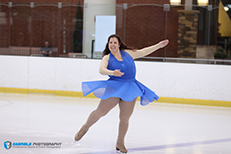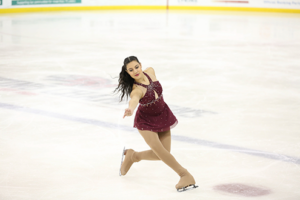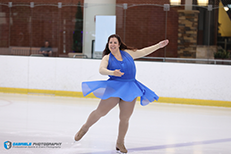Focus On: Open Solo Free Dance
Do you wish to compete in ice dance, but you can’t find a partner or would rather dance on your own? Then Open Solo Free Dance is for you!
This discipline of skating, which is included in ISI’s testing and competition offerings, has been growing in popularity with recreational and competitive skaters over the years. It features all of the elements of partnered free dance but without the lifts and couple elements. Emphasis is on demonstrating strong bilateral skating skills, power, edging, turn quality and variety, ice coverage, beautiful extensions, music interpretation, timing, ease of flow, transitions and style.
Duration and Judging Criteria

There are prescribed elements to each of the levels (Bronze, Silver, Gold, Platinum and Diamond). The same duration rules apply that are used for other ISI disciplines so skaters may be under the prescribed time without penalty.
Judging criteria includes: Test Level Maneuvers, Correctness, Interpretation, Extra Content, Pattern, Timing, Posture and General Overall. Please refer to The ISI Handbook for more detailed information.
The dance should reflect the character and rhythm of the music through the steps, turns, body movement and costuming. Examples of Open Solo Free Dance themes include cultural or ethnic musical theme (e.g., Latin or Irish), rhythm theme (e.g., rhumba, tango, march), Middle English theme (e.g., 1920s, 1930s) or artist theme (e.g., Beatles, Benny Goodman). The costuming should reflect the theme, period or story line of the routine. Skaters and coaches should be mindful that the dances should remain technical without becoming overly showy.

Open Solo Free Dance is a great way for coaches to capture skaters with stronger skating skills who may not want to pursue couples skating or difficult jumps. It’s also another great way for ice dancers to expand their horizons in dance by exploring more creative skating and a wider variety of musical themes.
Open Solo Free Dance Vs. Footwork/Artistic
You might be wondering how Open Solo Free Dance is different from either Footwork or Artistic?
Open Solo Free Dance
- Open Solo Free Dances should have a minimum of crossovers (no more than two) between elements and turns.
- A dancer should show their interpretation of their music with their “skating knees,” facial expression, and hand and arm movements.
- Stops should not be excessive and have a purpose to the music.
- Stops should be limited to four measures of music. Judges want to judge dance skating skills and not standstill dancing.
- Dance movements utilizing arms, hips, torso, core body and free leg movements should be evident throughout the program with a connection to the rhythm of the music and with a conscious attempt to accentuate them to the highlights in the music.
- Open Solo Free Dancers should always skate each step to the beat of the music with emphasis to the strong beat of the music. Dancers should try to have a variety of tempo in their music selection to show their interpretive abilities to a variety of music.
- A variety of rhythms should be explored to show the skater’s versatility to interpret a variety of dance rhythms.
Artistic
Artistic event programs will include more Freestyle skills so following the Open Solo Dance guidelines may not be possible. A good Artistic program should ideally utilize some of the character of a solo ice dancer, but there will also be more emphasis on athleticism than Free Dance.
Footwork
Footwork programs will have some of the characteristics of a Free Dance but likely not as much emphasis on dance skills. These routines will typically have more emphasis on turns and steps but not as much dance interpretation. As these programs are shorter, it will not always be possible to show a variety of tempos and rhythms in the music selection.

Established in 1959, the Ice Sports Industry (ISI) — creator of America’s first learn-to-skate curriculum — is an international trade association encompassing all aspects of the ice sports industry. Our goal is to promote ice skating as a participant sport and recreational activity for everyone — all ages and abilities. Learn more about the ISI Ice Skating Program.

 MY COACH ROCKS
MY COACH ROCKS TEAMS IN SYNC
TEAMS IN SYNC EXPRESS YOURSELF
EXPRESS YOURSELF FOCUS ON ARCHIVES
FOCUS ON ARCHIVES COMPETITORS’ CORNER
COMPETITORS’ CORNER NEWS & NOTES
NEWS & NOTES






